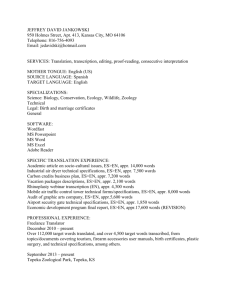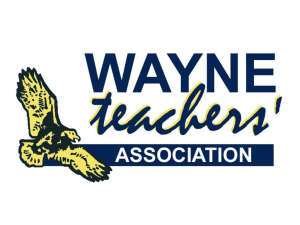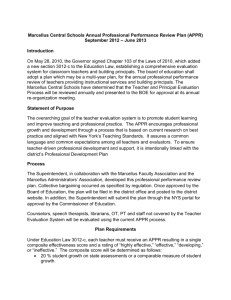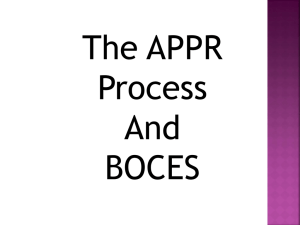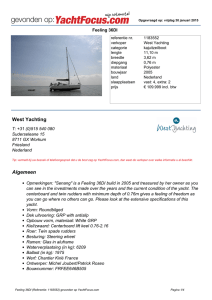APPR Facilitator`s Guide
advertisement
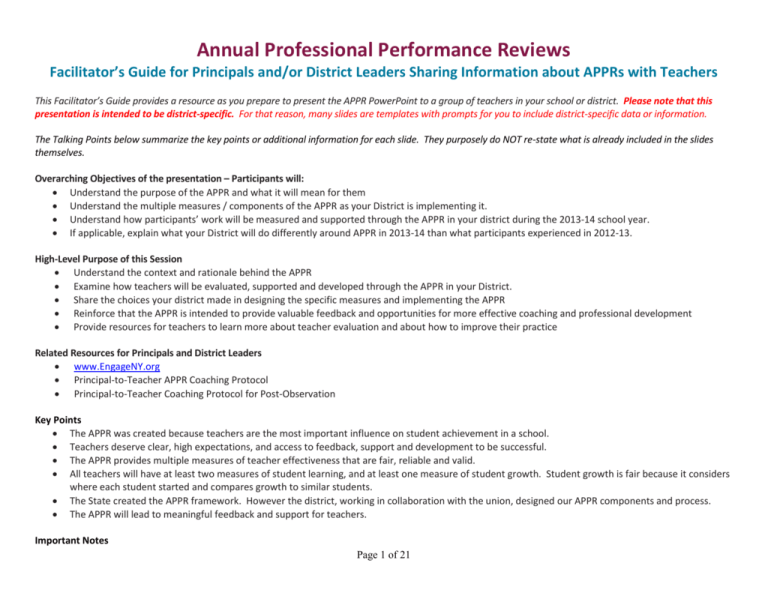
Annual Professional Performance Reviews Facilitator’s Guide for Principals and/or District Leaders Sharing Information about APPRs with Teachers This Facilitator’s Guide provides a resource as you prepare to present the APPR PowerPoint to a group of teachers in your school or district. Please note that this presentation is intended to be district-specific. For that reason, many slides are templates with prompts for you to include district-specific data or information. The Talking Points below summarize the key points or additional information for each slide. They purposely do NOT re-state what is already included in the slides themselves. Overarching Objectives of the presentation – Participants will: Understand the purpose of the APPR and what it will mean for them Understand the multiple measures / components of the APPR as your District is implementing it. Understand how participants’ work will be measured and supported through the APPR in your district during the 2013-14 school year. If applicable, explain what your District will do differently around APPR in 2013-14 than what participants experienced in 2012-13. High-Level Purpose of this Session Understand the context and rationale behind the APPR Examine how teachers will be evaluated, supported and developed through the APPR in your District. Share the choices your district made in designing the specific measures and implementing the APPR Reinforce that the APPR is intended to provide valuable feedback and opportunities for more effective coaching and professional development Provide resources for teachers to learn more about teacher evaluation and about how to improve their practice Related Resources for Principals and District Leaders www.EngageNY.org Principal-to-Teacher APPR Coaching Protocol Principal-to-Teacher Coaching Protocol for Post-Observation Key Points The APPR was created because teachers are the most important influence on student achievement in a school. Teachers deserve clear, high expectations, and access to feedback, support and development to be successful. The APPR provides multiple measures of teacher effectiveness that are fair, reliable and valid. All teachers will have at least two measures of student learning, and at least one measure of student growth. Student growth is fair because it considers where each student started and compares growth to similar students. The State created the APPR framework. However the district, working in collaboration with the union, designed our APPR components and process. The APPR will lead to meaningful feedback and support for teachers. Important Notes Page 1 of 21 The PowerPoint is designed for you to customize with local district-specific information. District-specific slides are indicated through an orange text box in the upper right-hand corner. Appendix slides provide additional information. You can insert these into your presentation or leave them in the appendix as you see fit. Note that the appendix includes one slide specific to Danielson and another slide specific to NYSUT’s teacher rubric. If your district does not use one of these rubrics, please delete the appropriate slide(s). We acknowledge that some districts may have reviewed most of this material in 2012-13. In that case, this shorter presentation may be used as a reminder/refresher and an update on anything that is new for the district in 2013-14. Session Outcomes What do we want participants to be able to do as a result of this session? Understand the purpose of the APPR and what it will mean for them Understand the multiple measures / components of the APPR Understand how their work will be measured and supported through the APPR How will we know that they are able to do this? Participants will be able to explain the subcomponents of the APPR to each other Participants and their colleagues will successfully implement conceptual understanding activities as described in the agenda Session Overview Section Time Opening 0:00-0:05 (5 min) College and Career Readiness 0:05-0:10 (5 min) Teacher Effectiveness Matters 0:10-0:15 (5 min) New York State APPR Overview 0:15-0:20 (5 min) Overview Frame the session, referencing the agenda Review session objectives Prepared Resources Session PowerPoint Facilitator’s Guide Facilitator Preparation Review session notes and PowerPoint presentation Discuss context and rationale behind the APPR Discuss the importance and current state of college and career readiness Identify links between the Common Core and teacher evaluation Session PowerPoint Facilitator’s Guide Any additional district materials as appropriate Review session notes and PowerPoint presentation Add district data related to graduation rates, college ready rates, achievement gaps and any other relevant facts as necessary Examine the impact effective teachers make on student academic and life outcomes Identify why previous evaluation system did not work Explain the benefits of the APPR Walk through the APPR subcomponents Identify the 4 rating categories Session PowerPoint Facilitator’s Guide Review session notes and PowerPoint presentation Session PowerPoint Facilitator’s Guide Review session notes and PowerPoint presentation Page 2 of 21 APPR/Evaluation and Support in Our District 0:20-1:00 (40 min) Closing 1:00-1:10 (10 min) TOTAL TIME 70min Clarify that state provided the APPR framework but the district, in collaboration with its union, designed the local APPR components and implementation Understand and discuss the specific elements of the APPR as designed by the district Examine State-calculated student growth measures and how they are calculated Understand Student Learning Objectives and how growth is measured in subjects without State-calculated growth scores Discuss feedback and support available to teachers based on APPR results Highlight any relevant slides in the appendix for teachers to review later Summarize key points of the session Reflect on next steps and what teachers can expect from the principal Reflect on the principal’s and teachers’ role to support teacher development, and other key support roles available in the school Session PowerPoint Facilitator’s Guide Review session notes and PowerPoint presentation Add district-specific information on APPR design and implementation – slides include some guiding questions or potential points to include but you must insert information (and potentially additional slides) as appropriate Review session notes and PowerPoint presentation Page 3 of 21 Session PowerPoint Facilitator’s Guide Session Roadmap Opening Time: 0:00-0:05 [5 minutes] In this section, you will… Time Materials used include: Frame the session, referencing the agenda Review the session objectives Slide #/ Pic of Slide Key Talking Points Slide 1 Slide 2 Session PowerPoint Facilitator’s Guide I brought you together today to understand Annual Professional Performance Reviews (APPR), why the state and our district have revised our approach to evaluation, and what this means for you. Ultimately, teacher evaluation and support are tools to help all of you, our teachers, do your very best work to prepare our students for college and careers. The revised APPR tool will give you more specific feedback, link to individualized support, and treat educators as the professionals we are. Over the next hour or so, we’ll look at the reasons behind the revised APPR, the different components of the APPR, and the implications for teachers based on APPR results. At the end of the day, the APPR was created to help teachers improve your practice. We know that teachers have the greatest impact on student learning, and we want to create a system that treats teachers respectfully and gives you the information you need to improve your practice. Page 4 of 21 College and Career Readiness Time: 0:05-0:10 [5 minutes] In this section, you will… Time Materials used include: Discuss context and rationale behind the APPR Discuss the importance and current state of college and career readiness Identify links between the Common Core and teacher evaluation Session PowerPoint Facilitator’s Guide Any additional district materials as needed. Slide #/ Pic of Slide Slide 3 Key Talking Points Ultimately, our goal is to prepare all students for college and careers Slide 4 With more education comes: o Higher income o Lower likelihood of being unemployed A student with a bachelor’s degree earns more than double the income of a student who doesn’t get a high school diploma A student who doesn’t earn a high school diploma is almost 3x more likely to be unemployed than a student with a bachelor’s degree Page 5 of 21 Time Slide #/ Pic of Slide Slide 5 Key Talking Points Education matters. So our goal – and challenge – is to ensure ALL of our students are prepared for college and careers (ASK THE GROUP – Facilitate a short conversation taking responses from the group) What stands out to you on this slide? What do you notice?s Slide 6 Slide 7 NY’s high school graduation rate is 74% But when you look at students scoring at least a 75 on the Regents English exam and 80 on the Math Regents, which is what correlates with success in first-year college courses, the numbers are even worse – only 35% of students are prepared for college and careers. The gaps are staggering and concerning. Only 12.5% of our African American students are graduating college and career ready, compared to 48.5% of our White students. Less than 10% of our English Language Learners and Students with Disabilities are college and career ready. Note orange box: Add district’s graduation rates, college ready rates, achievement gap data, and any other priority student achievement data or goals In our district, we must work together to increase graduation rates and college ready rates and reduce the achievement gap in order to ensure that ALL of our students are prepared for success The Common Core State Standards shift the way we think about what we teach and how we teach it. New York State is ahead of other states in implementing the Common Core. In addition to fully adopting the standards, we have made progress designing Common Core-aligned curricula, and we have begun to transition to Common Core-aligned assessments. We can no longer ask you, as teachers, to focus on one thing – the new standards – in the classroom and then evaluate you on something totally different. That is why we have worked hard to align our teacher evaluation system with the Common Core and ensure that it provides you with information to gauge how well you’re meeting students’ needs. Page 6 of 21 Teacher Effectiveness Matters Time: 0:10-0:15 [5 minutes] In this section, you will… Time Materials used include: Examine the impact effective teachers make on student academic and life outcomes Identify why previous evaluation system did not work Session PowerPoint Facilitator’s Guide Slide #/ Pic of Slide Slide 8 Key Talking Points To accomplish our goal to prepare ALL students for success in school and life, we must acknowledge the important role of teachers and support teachers in this critical work Slide 9 Teachers deserve development and support Teaching is a challenging and complex profession, and it takes great skill to meet the needs of every student in your classroom We want to treat each of you as the professional you are and give you the information you need about how you’re doing so that you can continue to improve your practice We also want to identify and celebrate teaching successes and support learning from one another Page 7 of 21 Time Slide #/ Pic of Slide Slide 10 Key Talking Points Effective teaching CAN be measured This graph illustrates the impact one teacher can make For example, the bar on the right shows that a student with a high-performing teacher can learn more than 11 months more than a student with a low-performing teacher – That’s more than one school year of learning gained by a student with an effective teacher Slide 11 We all expect teachers to impact student achievement But research now shows that a great teacher – even for just one year – can change the trajectory of a child’s life Slide 12 Our previous evaluation system did not provide us with the information or support we needed in order to improve our work. Most teachers were rated at the top of the scale, even though most teachers felt there was at least one poor-performing teacher in each school. Teachers did not receive helpful feedback and we were losing some of our strongest teachers Take a minute and write down one thing you heard that surprised you in what I’ve shared so far. Turn and talk with a partner at your table your response. (Allow 2 minutes for turn and talk, and then facilitate a short discussion) New York State APPR Overview Page 8 of 21 Time: 0:15-0:20 [5 minutes] In this section, you will… Time Materials used include: Explain the benefits of the APPR Walk through the APPR subcomponents Identify the 4 rating categories Session PowerPoint Facilitator’s Guide Slide #/ Pic of Slide Slide 13 Script/ Activities directions Let’s discuss what the APPR looks like overall Then we will discuss the specifics of our APPR in (X district) Slide 14 This is a comprehensive evaluation and support system for teachers that includes: o Clear expectations for you as teachers o Frequent, actionable, helpful feedback to help you improve o Annual evaluations o Multiple measures – This makes our evaluation more reliable, rigorous, and valid. It also ensures no one is evaluated on a single test score o 4 ratings levels (as opposed to the previous satisfactory/unsatisfactory system) o Evaluations will matter – recognition and rewards as well as potential consequences for ineffective teachers Page 9 of 21 Time Slide #/ Pic of Slide Slide 15 Script/ Activities directions Teachers will receive 1 of 4 ratings – Highly Effective, Effective, Developing, Ineffective Multiple measures help ensure a comprehensive look at teacher effectiveness 3 components: o Teacher Practice is largest part – 60% - observations of what you do in the classroom o Student Learning makes up 40% and has 2 parts: Student Growth Local Measures Each 20% We will discuss specifics in our district shortly Page 10 of 21 APPR/Evaluation and Support in Our District Time: 0:20-1:00 [40 minutes] In this section, you will… Time Materials used include: Clarify that state provided the APPR framework but the district, in collaboration with its union, designed the local APPR components and implementation Understand and discuss the specific elements of the APPR as designed by the district Examine State-calculated student growth measures and how they are calculated Understand Student Learning Objectives and how growth is measured in subjects without State-calculated growth scores Discuss feedback and support available to teachers based on APPR results Session PowerPoint Facilitator’s Guide Slide #/ Pic of Slide Slide 16 Script/ Activities directions Now let’s discuss what this looks like in practice in our district. Slide 17 Note Orange Box: Add information on which teacher practice rubric you use and how you have engaged educators in designing and providing feedback on the evaluation system Although the state provided a guiding framework for the APPR, all design and implementation decisions were made locally by the district in collaboration with our union We will discuss our design choices and what they mean for you in this next section Page 11 of 21 Time Slide #/ Pic of Slide Slide 18 Script/ Activities directions Note orange box: Add information related to your observation tool (e.g., number of observations, who will observe, other details) and any other measures of teacher practice (e.g., surveys, portfolios, artifacts). If you have multiple teacher practice measures, indicate number of points allocated to each. A majority of points come from teacher practice - not growth measures Observations will be evidence-based All evaluators will be trained and certified If appropriate… our district will also use X as an additional measure of teacher practice. We selected this for Y reason and it will look like Z in practice. Slide 19 40% of your overall rating will be based on student learning There are 2 components here – each worth 20% Slide 20 Before sharing this presentation, determine whether you want to change the slide’s headline to the alternative headline in the orange box in upper right-hand corner. . All teachers will have at least one measure of student growth o Help teachers understand that this applies to everyone, not just teachers who receive a State-calculated growth score. Measuring student growth is a more accurate and fair way of identifying teacher contributions to student learning Page 12 of 21 Time Slide #/ Pic of Slide Slide 21 Script/ Activities directions Growth measures student performance from one year to the next Then students are compared to similar students (who had the same test score the previous year) This helps us understand one student’s growth relative to similar students We can then assign a Student Growth Percentile score which indicates that a student performed better than X% of his/her peers Slide 22 Let’s walk through an example… Within a single class, students enter at different achievement levels Let’s look at one student – Tanisha Based on this information, what can you say about Tanisha’s 1) level of proficiency and 2) growth as compared to other students? Turn and talk with a partner at your table your response. (Allow 2 minutes for turn and talk, and then facilitate a short discussion) Ensure the following comes out during the discussion: o Tanisha was not proficient in either year o We do not yet have enough information to tell whether her growth is high, low, or typical compared to similar students o Note: Although some will want to subtract her two scores to come up with a growth score, NY tests do not work that way since tests and scale scores are not always consistent from year to year. The NY model takes these realities into account and creates a fair growth score regardless. Page 13 of 21 Time Slide #/ Pic of Slide Slide 23 Script/ Activities directions Tanisha scored 600 in 2011-12 (red dot on the left) She is compared to similar students who also scored 600 in 2011-12 Tanisha scored 640 in 2012-13 (red dot on the left) Other students had a range of scores in 2012-13 (blue dots on the left) When all of these students are compared, Tanisha scored above 60% of her similar peers Slide 24 Slide 25 We do not measure growth compared to similar students alone We recognize that a variety of factors affect students, and the state growth model takes these factors into account Factors include characteristics related to previous academic history, special needs/disabilities, English Language Learners, and poverty This ensures that all educators can demonstrate effectiveness regardless of the composition of his/her classroom We also take student enrollment and attendance into account by weighting each student’s SGP accordingly Educators receive a Mean Student Growth Percentile (MGP) based on the SGPs of students in their classrooms Page 14 of 21 Time Slide #/ Pic of Slide Slide 26 Script/ Activities directions We expect 2012-13 rating distribution to be similar to this past year Majority of teachers (84%) were rated Highly Effective or Effective in this component Slide 27 Slide 28 Note the orange box: Add specifics about SLOs and local measures for each group of teachers (grades 4-8 ELA and math, teachers in other subjects/grades with state tests) Our growth and local measures are DIFFERENT – we are not double-counting the same measure in two places Teachers of grade 4-8 ELA and math will receive a state-calculated growth score PLUS X local measures Teachers in other subjects/grades that have state tests will set SLOs based on those state tests PLUS X local measures Note the orange box: Add specifics about which assessments are used for the growth and local measures. For local measures, note whether the measure is based on growth or achievement/proficiency. All teachers will be measured on student growth. In grades and subjects without state assessments (“non-tested grades and subjects”), we will use the following measures These measures look like X in practice and Y is the reason we selected these measures and assessments. Page 15 of 21 Time Slide #/ Pic of Slide Slide 29 Script/ Activities directions Evaluation and development are an ongoing cycle – this is not evaluation in isolation or a gotcha approach Specific evidence will help us identify each teacher’s strengths and growth areas, share specific feedback based on evidence, and differentiate support based on individual needs Together, these steps will help teachers reflect on your practice and identify ways to improve your craft to increase student learning Slide 30 Slide 31 Include any district-specific aspects of Teacher Improvement Plans Teacher Improvement Plans (TIPs) will help ensure that struggling teachers receive support to improve TIPS must include specific components in order to provide a focused, clear plan of action for improvement Note the orange box: Add specifics about district appeals process, implications for Ineffective ratings, and other important aspects of your APPR Page 16 of 21 Time Slide #/ Pic of Slide Slide 32 Script/ Activities directions Note orange box: Review the current bullets – edit or delete as appropriate. Add other specifics as appropriate. We had many successes and learned many lessons from our APPR process in 2012-13 For 2013-14, we are taking additional steps to make the APPR even more helpful to you as teachers Slide 33 Note orange box: Add specifics about where teachers can access more information – the slide lists some potential categories of resources to include I encourage you to learn more about our APPR system in our district. You can learn more by… Page 17 of 21 Closing Time: 1:00-1:15 [10 minutes] In this section, you will… Time Materials used include: Highlight any relevant slides in the appendix for teachers to review later Summarize key points of the session Reflect on next steps and what teachers can expect from the principal Reflect on the principal’s and teachers’ role to support teacher development, and other key support roles available in the school Session PowerPoint Facilitator’s Guide Slide #/ Pic of Slide Slide 34 Script/ Activities directions If you are not discussing any of the following slides, include these talking points here. If you want to discuss the following slides, move these talking points to the end. I hope today’s discussion helped you o Understand the purpose of the APPR and what it will mean for you o Understand the multiple measures / components of the APPR o Understand how your work will be measured and supported through the APPR Again, this is designed to support you as educators and help us with our shared goal of ensuring our students are ready for college and careers I look forward to working with you – individually and as a team – to identify strengths, share promising practices, pinpoint growth areas, and help you improve your practice so that you can have a tremendous impact on the students you teach Slide 35 Before sharing this presentation, keep this slide if you use a Danielson-based teacher practice rubric AND delete the orange box in the upper right-hand corner. Delete the slide if you use a different rubric. Our rubric is aligned to our Common Core implementation Domain 1: Planning and Preparation links to the content of the Common Core Domain 3: Instruction links to the pedagogy and instructional practices required to successfully implement the Common Core Page 18 of 21 Time Slide #/ Pic of Slide Slide 36 Script/ Activities directions Before sharing this presentation, keep this slide if you use an NYSUT-based teacher practice rubric AND delete the orange box in the upper right-hand corner. Delete the slide if you use a different rubric. Our rubric is aligned to our Common Core implementation Standard 2: Knowledge of Content and Instructional Planning links to the content of the Common Core Standard 3: Instructional Practice links to the pedagogy and instructional practices required to successfully implement the Common Core Slide 37 Classroom teachers who are “teacher of record” will be evaluated under this revised APPR The chart specifies who will and will not be evaluated by the APPR Slide 38 The State provided guidance on the 4 rating categories across the 3 components of the APPR In short: o Highly Effective exceeds standards and gets results well above expectations and state averages o Effective meets standards and gets results at expectations and state averages o Developing needs improvement in order to meet standards and gets results below expectations and state averages o Ineffective does not meet standards and gets results well-below expectations and state averages Page 19 of 21 Time Slide #/ Pic of Slide Slide 39 Script/ Activities directions The Bill & Melinda Gates Foundation’s Measures of Effective Teaching (MET) Initiative was a 3year study across multiple districts Their research findings provide clear evidence of what good evaluation systems look like The APPR incorporates these research-based practices Slide 40 Slide 41 The State provided the framework for the APPR However, each district – in collaboration with our unions – designed our own evaluation and support system within the State framework This slide provides specifics about which components were determined locally or by the State All teachers will receive at least one measure of student growth Some teachers will receive State-provided growth measures – usually grades 4-8 ELA and math Other teachers will create Student Learning Objectives The biggest differentiator in whether you get a State-provided growth measure or create an SLO is the % of students you teach who are covered in grades/subjects where the State provides growth scores Teachers who teach grades/subjects with state assessments must create SLOs related to those assessments Page 20 of 21 Time Slide #/ Pic of Slide Slide 42 Script/ Activities directions Student Learning Objectives allow us to measure growth in grades and subjects that do not get State-provided growth scores SLOs should: o Represent the most important learning for the year o Be based on prior student learning data o Align to standards o Be specific and measurable Slide 43 I encourage you to view these additional resources for more information on teacher evaluation overall, components of the APPR, and Common Core implementation tools. Page 21 of 21
